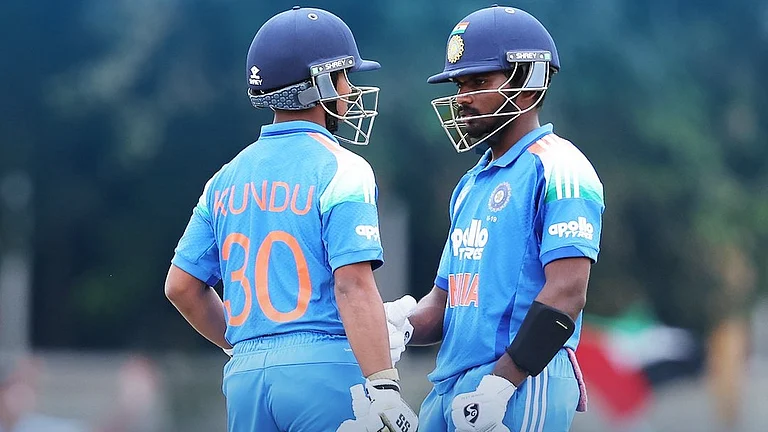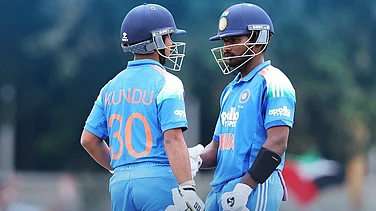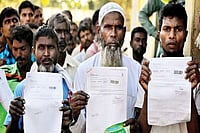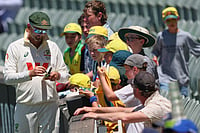In a grainy YouTube video, football legend Gerd Muller describes how Germany defeated a great Netherlands side in the 1974 World Cup final. The whole conversation is brutally simple. "A German team is not easy to bring down. We fought more than ever in that final, our best came on the last day," Muller says in a feeble voice. Those words are eerily similar to Pat Cummins' "best for the last" comment after Australia plotted a marauding India's downfall in the title clash of the 2023 cricket World Cup. (As It Happened | Scorecard | Full Coverage)
In fact, the champion sides think alike. Their disciplines might differ, but methods to success remain comparable. And Australia is an iron-willed champion side, more so in the knockout stages of a global event. A look back to their last two matches in the showpiece will reveal that facet of their game. Both India and South Africa, their opponents in the semifinals, were perceived to be far superior despite the Aussies winning seven matches in a row to reach the knockouts.
The Australian pacers struggled to make an impact of desired levels during the entirety of the league stage but they returned to the best in the first available opportunity. The Kolkata weather and the Eden pitch helped them purchase some swing and bounce, and the triumvirate of Mitchell Starc, Josh Hazlewood and Cummins blew away the Proteas, sharing eight wickets among them.
On a progressively slowing down surface, the Aussies found batting saviours in Josh Inglis, Starc and Cummins after South Africa's bowlers reduced them to a shaky 137 for five. However, Australia's grunt work was pushed under the table as the focus was more on South Africa's inclination to choke on these big moments.
But Australia's real challenge was against India in the summit clash. This was not just another Indian team as under Rohit Sharma they had assembled one of the finest ODI outfits in their entire history. They did not merely beat their opponents but lorded over them imperiously in 10 successive matches, something no other Indian team was able to achieve in the marquee event dating back to 1975.
Strangely, Rohit's band was a mirror image of the dominant Australians at the turn of the century, an era when they went undefeated in 29 matches across three editions in 1999, 2003 and 2007. In a way, Cummins' side had to beat India who was playing the Australian way. Australia were the underdogs, or so thought several of us.
So, what did Australia do? As Muller said in that interview, they found a way to fight even more than ever. Cummins believed in the big match temperament of his bowlers and elected to bowl against an Indian batting unit that had been firing on all cylinders. There has been this common observation that a certain softness has seeped into the Aussies post the 'Sandpaper Gate'. Perhaps, India's two Test series win Down Under too might have added to that perception.
But it is quite wrong. Yes, they no longer indulge in outrageous pre-match predictions or target the opposition captains with a barrage of tactical verbal volleys. However, there is a silent resilience beneath that soft exterior, which is even more frightening than their previous brazen, in-your-face aggression. You just can't gauge their mindset from their words. It's all action.
The Australian bowlers showed the way. After conceding 10 boundaries in the first Power Play segment, they limited a batting line-up comprising Virat Kohli, Shreyas Iyer, KL Rahul, Ravindra Jadeja and Suryakumar Yadav to just four fours in the next 40 overs. It was hard to imagine that this was the same India which piled up three 300-plus and one 400-plus total in their last four matches.
But then Australia needed someone to guide their chase of 241 on a fiddly pitch on which the Indian bowlers reduced them to 47 for three. A South Australian with a handlebar moustache – Travis Head – answered the ring along with Marnus Labuschagne. Head took down the Indians with a bit of hostility, while Labuschagne did that with patience. Labuschagne, in fact, embodied this Australia.
He was ready to play second fiddle to Head without ever trying to outscore his partner. It was dirty, unglamourous work but Labuschagne read the situation beautifully and responded to it. It was a seamless buy-in from the whole team, which dragged India out of their comfort zone. Once Aussies entered that fighting zone, India forgot their own on a vastly sobering evening.


























